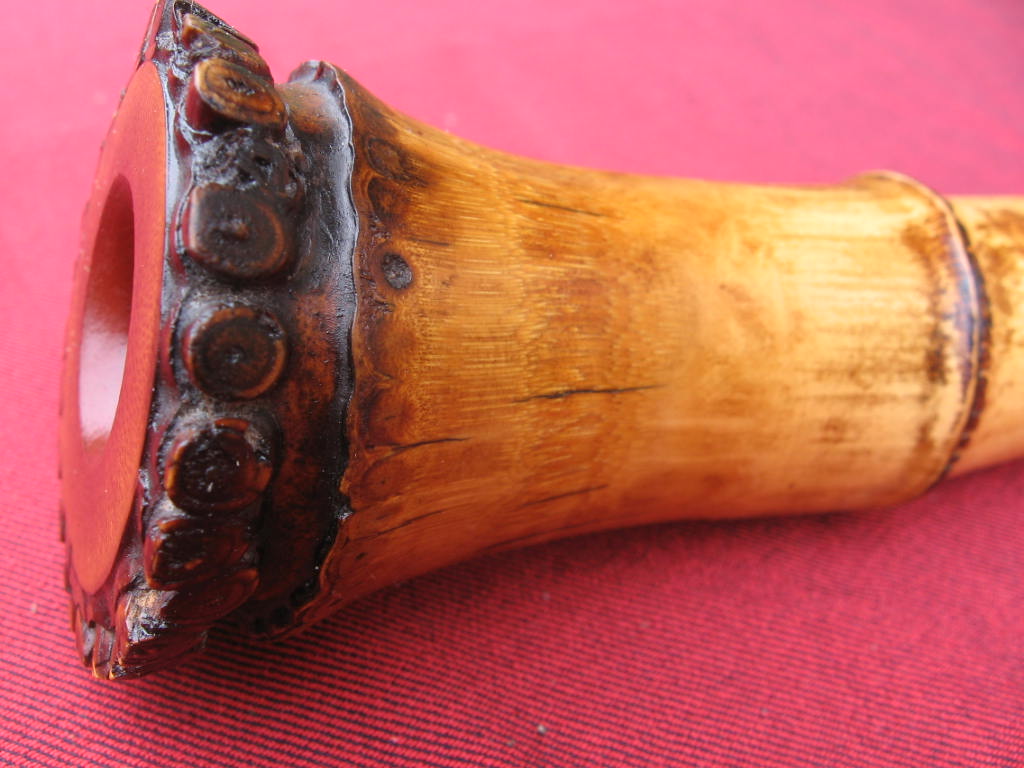Mujitsu and Tairaku's Shakuhachi BBQ
World Shakuhachi Discussion / Go to Live Shakuhachi Chat
You are not logged in.
Tube of delight!
#1 2006-06-20 17:24:32
Finishing root sections
I'm happy with a mostly-subtractive approach to flutemaking. I'm ending up with very satisfying fat jinashi nobekan (dare I say hocchiku). But this is leaving carefully filed and sanded roots in a dull, unfinished state, to my eye. So I'm looking for good ways to finish roots to that polished, glassy look.
I'm not scared of elbow grease, but steel wool or oils don't really work well down there. I haven't tried the rottenstone slurry idea from Ken, but I think there are too many nooks and crannies for that approach to polishing. Or maybe I'm wrong.
I don't have the luxury of throwing away test root pieces, otherwise I'd even try some -gasp- polyurethane in that area.
Or maybe it's time to get my feet wet in urushi. So to speak. No experience with that substance yet, but I'm willing to try.
Root-finishing experiences to share? Thanks!
-Darren.
When it is rainy, I am in the rain. When it is windy, I am in the wind. - Mitsuo Aida
Offline
#2 2006-06-20 18:13:47
- evan kubota
- Member
- Registered: 2006-04-10
- Posts: 136
Re: Finishing root sections
What grit of sandpaper are you going up to? I find that if I use up to 1200 or 2000 it is quite smooth and even satin finish already (with nothing applied). I've been using a light coat of tung oil on some of my root ends. Use several coats. For additional luster, try the gloss type.
Some Japanese flutes look like urushi was applied. Somewhere else walnut oil mixed with bamboo dust was recommended to darken/stain/polish/seal raw bamboo surfaces. I'm not sure how well this works, but it sounds interesting.
Offline
#3 2006-06-21 01:23:34
Re: Finishing root sections
Darren,
These are some techniques I've used:
Initially, the roots can be ground down with a file. Then, they can be smoothed further with long strips of sandpaper using a 'shoeshine' technique. (Coarse, medium, fine, then as fine as you want) If you like, rub in some rottenstone/oil mixture, then buff with a clean cloth using the shoeshine technique as well. This step can be repeated many times.
The roots can be stained with a very small amount of urushi and turpentine if desired. Buff after it cures in a humid box.
All this takes awhile. That way, you can make it rugged, medium or as glossy as you like.
Ken
Offline
#4 2006-06-22 19:17:36
Re: Finishing root sections
Thanks for the detailed tips, Ken. I'll try the rottenstone buffing method on one soon. I'll obtain some urushi later this week but I will try a tiny bit of cherry stain on the roots first because it's simpler and cleaner. (This is beautiful but unaged Japanese madake, so it's very fair in color.) Without urushi, staining bamboo skin seems mostly impossible to me (from what I've tried) but the root area after sanding will take a stain better. Sorry, that was cherry wood color, not "cherry" the fruit...
I'm in no rush (two flutes are now playing in tune sufficiently, so blowing comes first!) but I'll share my results when I have them...
-Darren.
When it is rainy, I am in the rain. When it is windy, I am in the wind. - Mitsuo Aida
Offline
#5 2009-07-31 13:33:56
Re: Finishing root sections
I know this is an older thread, but thought i'd share anyhow.
One tool I have found to be useful with polishing the root end and bamboo in general are those nail polish buffing blocks and files. Remove with with various grades of files, then switch to sand paper or these things.
http://www.phishie.com/wordpress/wp-con … 000041.jpg
http://beaut.ie/blog/wp-content/uploads … _block.jpg
I find them useful because they have some rigidity and can conform to the shape of the bell, and can run the gamut as far as grit goes. With the polishing blocks you can achieve a pretty significant polish.
There is also the method of burnishing the root end with a glazed porcelain cup or object to achieve a high polish, as outlined by Yoneda Chikamitsu in Kudo's craft manual.
Coming, all is clear, no doubt about it. Going, all is clear, without a doubt.
What then is all? -Hosshin
Offline
#6 2009-08-07 12:56:26
- Toby
- Shakuhachi Scientist

- From: out somewhere circling the sun
- Registered: 2008-03-15
- Posts: 405
Re: Finishing root sections
My secret is a boar tusk. I got it on the island of Kiriwina in Papua New Guinea, where the wood carvers use it to polish their creations. But actually it doesn't need to be a tusk: any smooth, hard and ROUNDED object will do the trick. Simply rub the object hard over any area you want to shine up, including the area between the root rings. If it is quite smooth to begin with this will help it sparkle.
Toby
Offline
#7 2009-08-11 22:42:37
- Windsiu
- Member

- Registered: 2008-08-26
- Posts: 5
Re: Finishing root sections
I first file or saw away the excess roots. Then I use a Dremel tool with the small sand cylinder soaked in linseed or tung oil. I like the well-used cylinders because its not as coarse and I can get a nice shin. I put masking tape around the exposed bamboo areas between the nodes so as to protect it in case I accidentally run the sander on the bare bamboo. Then I sand each little round root ends carefully and make sure they are even with each other. After a few passes they will come out nice and shinny smooth..... Wind (Henry)
Last edited by Windsiu (2009-08-11 22:43:13)
Offline
#8 2009-08-12 11:43:53
Re: Finishing root sections
Wow! fantastic tips people!
Another polishing technique I've stumbled onto is using a 5" sanding disc attached to a drill. For polishing, a well worn (shiny) 600 grit sand paper circle gives the roots a nice shine. Doesn't work too well for convex polishing a few root rings up though. I've had better luck getting that type of elegant bell curve by hand. (See photo)
Offline
#9 2009-08-12 13:12:17
- Taldaran
- Member

- From: Everett, Washington-USA
- Registered: 2009-01-13
- Posts: 232
Re: Finishing root sections
I use one of those Dremel rotary and Multi-Max tools to do the rough work (taking off excess roots with wood saw attachment, and rough sanding and utaguchi work with the detail sanding attachment). Then with wet/dry sandpaper and steel wool for the shaved root areas.
Christopher
“Whoever can see through all fear will always be safe.” Tao Te Ching
Offline
